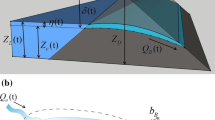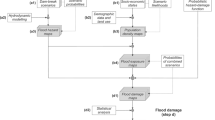Abstract
The traditional and still prevailing approach to characterization of flood hazards to dams is the inflow design flood (IDF). The IDF, defined either deterministically or probabilistically, is necessary for sizing a dam, its discharge facilities and reservoir storage. However, within the dam safety risk informed decision framework, the IDF does not carry much relevance, no matter how accurately it is characterized. In many cases, the probability of the reservoir inflow tells us little about the probability of dam overtopping. Typically, the reservoir inflow and its associated probability of occurrence is modified by the interplay of a number of factors (reservoir storage, reservoir operating rules and various operational faults and natural disturbances) on its way to becoming the reservoir outflow and corresponding peak level—the two parameters that represent hydrologic hazard acting upon the dam. To properly manage flood risk, it is essential to change approach to flood hazard analysis for dam safety from the currently prevailing focus on reservoir inflows and instead focus on reservoir outflows and corresponding reservoir levels. To demonstrate these points, this paper presents stochastic simulation of floods on a cascade system of three dams and shows progression from exceedance probabilities of reservoir inflow to exceedance probabilities of peak reservoir level depending on initial reservoir level, storage availability, reservoir operating rules and availability of discharge facilities on demand. The results show that the dam overtopping is more likely to be caused by a combination of a smaller flood and a system component failure than by an extreme flood on its own.




















Similar content being viewed by others
References
Baecher GB, Hartfor DND, Patev RC, Rytters K, Zielinski PA (2013) Understanding spillway systems reliability. In: Proceedings of ICOLD 81st annual symposium, Seattle, pp 1241–1250
CDA (2007) Dam safety guidelines. Canadian Dam Association, Edmonton
Cunnane C (1978) Unbiased plotting positions—a review. J Hydrol 37:205–222. doi:10.1016/0022-1694(78)90017-3
FEMA (2012) Summary of existing guidelines for hydrologic safety of dams, FEMA report P-919
FEMA (2013) Selecting and accommodating inflow design floods for dams, FEMA report P-94
Gross E, Lord DW (2014) Why are dams failing before they reach their spillway design capacity? In: Proceedings of the 34th annual USSD conference, San Francisco
Hansen EM, Fenn DD, Corrigan P, Vogel JL, Schreiner LC, Stodt RW (1994) Probable maximum precipitation for Pacific Northwest States—Columbia River (including portions of Canada), Snake River and Pacific coastal drainages, hydrometeorological report No. 57, US National Weather Service, Silver Spring
Hartford DND, Baecher GB (2004) Risk and uncertainty in dam safety. Thomas Telford Publishing, London
Hobbs G (2003) Spillway gates—a survey of operational and reliability issues. Paper presented at 2003 ANCOLD conference, Hobart
Hosking JRM, Wallis JR (1997) Regional frequency analysis—an approach based on L-moments. Cambridge University Press, Cambridge
Hsu YC, Tung YK, Kuo JT (2011) Evaluation of dam overtopping probability induced by flood and wind. Stoch Env Res Risk Assess 25(1):35–49. doi:10.1007/s00477-010-0435-7
Kuo JT, Hsu YC, Tung YK, Yeh KC, Wu JD (2008) Dam overtopping risk considering inspection program. Stoch Environ Res Risk Assess 22(3):303–313. doi:10.1007/s00477-007-0116-3
Kwon HH, Moon YI (2006) Improvement of overtopping risk evaluations using probabilistic concepts for existing dams. Stoch Environ Res Risk Assess 20(4):223–237. doi:10.1007/s00477-005-0017-2
Lewin J, Ballard G, Bowles DS (2003) Spillway gate reliability in the context of overall dam failure risk. In: Proceedings of the 23rd annual USSD conference, Charleston, ISBN: 9781884575327
McKay MD, Conover WJ, Beckman RJ (1979) A comparison of three methods for selecting values of input variables in the analysis of output from a computer code. Technometrics 21:239–245
Micovic Z, Quick MC (1999) A rainfall and snowmelt runoff modelling approach to flow estimation at ungauged sites in British Columbia. J Hydrol 226:101–120. doi:10.1016/S0022-1694(99)00172-9
Micovic Z, Quick MC (2009) Investigation of the model complexity required in runoff simulation at different time scales. Hydrol Sci J 54(5):872–885. doi:10.1623/hysj.54.5.872
Micovic Z, Schaefer MG, Barker BL, Taylor GH (2012) Development of hydrologic hazard curves for assessing hydrologic risks at dams on the Campbell River, BC. In: Proceedings of the Canadian Dam Association annual conference, Saskatoon
Micovic Z, Schaefer MG, Taylor GH (2015) Uncertainty analysis for probable maximum precipitation estimates. J Hydrol 521:360–373. doi:10.1016/j.jhydrol.2014.12.033
Nathan RJ, Weinmann PE (2003) Use of Monte Carlo simulation to estimate the expected probability of large to extreme floods. In: Proceedings of 2003 hydrology and water resources symposium, IE Aust., Wollongong, pp 1.105–1.112
National Research Council (1985) Safety of dams: flood and earthquake criteria. National Academy Press, Washington
Paquet E, Garavaglia F, Gailhard J, Garçon R (2013) The SCHADEX method: a semi-continuous rainfall-runoff simulation for extreme flood estimation. J Hydrol 495:23–37. doi:10.1016/j.jhydrol.2013.04.045
Quick MC (1995) The UBC Watershed Model. In: Singh VJ (ed) Computer models of watershed hydrology. Water Resources Publications, Highlands Ranch, pp 233–280
Schaefer MG, Barker BL (2001) Stochastic event flood model (SEFM). In: Singh VJ, Frevert DK (eds) Mathematical models of small watershed hydrology and applications. Water Resources Publications, Highlands Ranch, pp 707–748
Schaefer MG, Barker BL (2009) Stochastic event flood model—user’s manual, MGS Engineering Consultants, Inc., Olympia
Stedinger JR, Vogel RM, Foufoula-Georgiou E (1992) Frequency analysis of extreme events. In: Maidment DR (ed) Handbook of hydrology, vol 18. McGraw Hill, New York
USBR (2013) Appurtenant structures for dams (spillways and outlet works), design standards no. 14, phase 4, Chapter 2: hydrologic considerations, U.S. Department of Interior
Wyss GD, Jorgenson KH (1998) A user’s guide to LHS: Sandia’s Latin hypercube sampling software, Sandia National Laboratories, Report SAND98-0210
Zielinski PA (2011) Inflow design flood and dam safety. In: Schleiss AJ, Boes RM (eds) Dams and reservoirs under changing challenges. CRC Press, Taylor & Francis Group, London, pp 677–684
Author information
Authors and Affiliations
Corresponding author
Rights and permissions
About this article
Cite this article
Micovic, Z., Hartford, D.N.D., Schaefer, M.G. et al. A non-traditional approach to the analysis of flood hazard for dams. Stoch Environ Res Risk Assess 30, 559–581 (2016). https://doi.org/10.1007/s00477-015-1052-2
Published:
Issue Date:
DOI: https://doi.org/10.1007/s00477-015-1052-2




